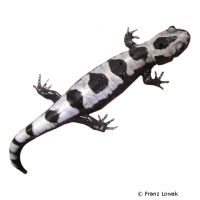Marbled Salamander (Ambystoma opacum)
| Marbled Salamander Ambystoma opacum | |
|---|---|
| Name | Marbled Salamander |
| Name Lat. | Ambystoma opacum |
| Synonym | Salamandra opaca |
| Family | Mole Salamanders |
| Family lat. | Ambystomatidae |
| Order | Salamanders |
| Order lat. | Caudata |
| Origin | North America |
| Habitat | Wetlands |
| Diet | Carnivore |
| Humidity | 70-90 % |
| Behavior | Semi-aggressive |
| Keeping | Individual, group |
| Care Level | Moderate |
| Breeding | Simple |
| Housing | Humid terrarium |
| Life Span | 15 years |
| Protection | No |
| Metric Units | |
| Size | 10 cm |
| Temperature | 16-20 °C |
| Housing Size | 100 x 60 x 50 cm |
| US Units | |
| Size | 3.9" |
| Temperature | 61-68 °F |
| Housing Size | 40" x 25" x 20" |
Distribution and habitat
The range of the primarily crepuscular to nocturnal marbled cross-toothed newt is the southeastern United States, extending from New Hampshire to northern Florida and from Louisiana to Texas. There are several populations that differ in coloration and markings. They live in deciduous forests near bodies of water and in marshes, usually hidden in loose substrate
Maintenance
The data are the minimum dimensions for the terrarium, according to the size and number of animals:
| 1-2 animals | ground area in m²: GL x 0,01 |
The total length (GL) is measured at the largest animal. For each additional animal the floor space has to be increased by 25 %. A terrarium of L 100 x W 60 x H 50 cm is recommended, which should be placed in a quiet and vibration-free place.
They need a terrarium structured with roots, flat stones and cork tubes (hiding places and visual protection), a moisture-retaining substrate, e.g. of bark mulch-soil mixture with peat, foliage and sphagnum moss as well as a shallow, easy-to-clean water basin as drinking and bathing vessel. To allow burrows to be dug, the substrate should be about 20 cm deep in some places and about half should always be kept moist. Ficus pumila and Scindapsus, for example, are suitable for planting. Once a day, preferably in the evening, the inside of the terrarium should be finely sprayed with water (humidity), but a rain or mist system is better.
| Temp. day: 16-20 °C | Temp. night: 14-18 °C | Humidity: 70-90 |
Lighting with daylight fluorescent tubes must be 12-14 hrs, depending on the season.
Diet
The food supply should preferably consist of crickets, house crickets, grasshoppers, maggots, caterpillars, earthworms, millipedes, slugs, zophobas and mealybug larvae, supplemented with commercially available special food mixtures for insectivorous reptiles. Feeding animals should be enhanced by gifts of ripe fruits or vegetables before feeding. It is important to add minerals and vitamins regularly, e.g. by pollinating the feeders. Adult animals should be offered food daily, young animals several times a day.
A varied diet promotes health and prevents deficiency symptoms.
Reproduction and breeding
Courtship, mating and egg laying take place on land. The female lays between 30 and 200 eggs in a moist depression and guards them. When the rains begin, the eggs are flooded and washed into a nearby body of water, where the gill-bearing larvae hatch. This marks the end of the female's brood care. After 2-3 months the transformation (metamorphosis) is complete and they leave the water
Flake or granulated food for ornamental fish and small live food (Artemia nauplii, Cyclops) are suitable as rearing food.
Important
Direct sunlight and temperatures above 20 °C are not tolerated in the long term.
They can climb vertically on glass panes, accordingly the terrarium must be well covered.
A resting period of 2-3 months is recommended. For this, the lighting duration must be shortened by 4-6 hours and the temperature lowered to 5-10 °C, depending on the origin.
Before purchase, a terrarium should be prepared that meets the species-specific needs. Good ventilation without drafts is necessary, as well as equipment for measuring temperature and humidity. The lighting has to correspond to the species-specific day-night rhythm and should be placed in such a way that the animals cannot injure themselves. The terrarium should be locked in such a way that neither unauthorized persons can open it nor the animals can escape. Special attention must be paid to thorough hygiene and impurities must be removed regularly.
Further literature can be found in your pet store
References
Text: Serena Werle; Image: Franz Lowak
Source: ENGELMANN (2006): Zootierhaltung - Tiere in menschlicher Obhut: Reptilien und Amphibien, Harri Deutsch Verlag; VDA & DGHT (2006): Allgemeine Haltungsrichtlinien für Molche und Salamander
- Gemäß § 21 Abs. 5 Tierschutzgesetz idgF
